
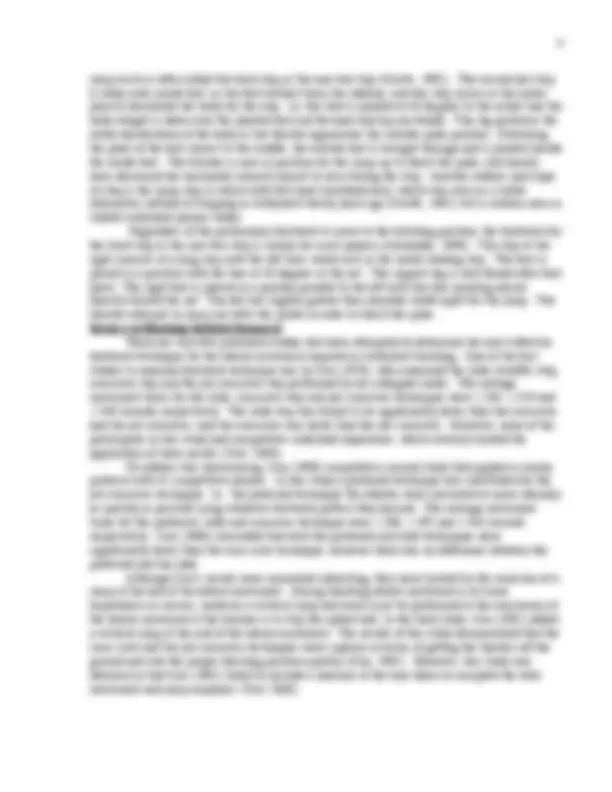
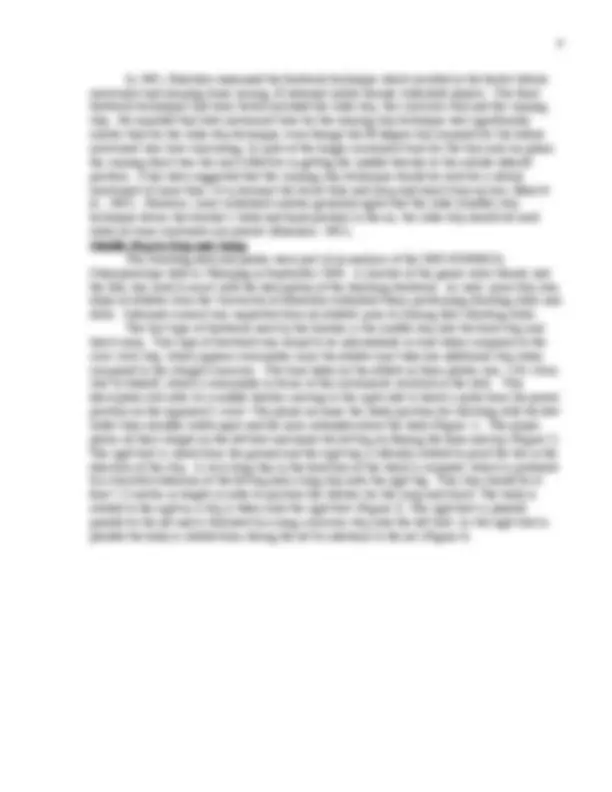
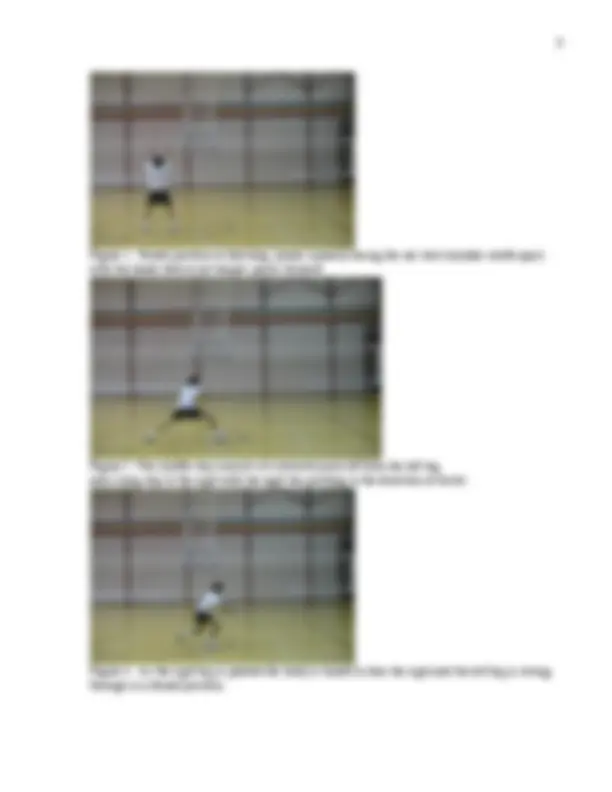
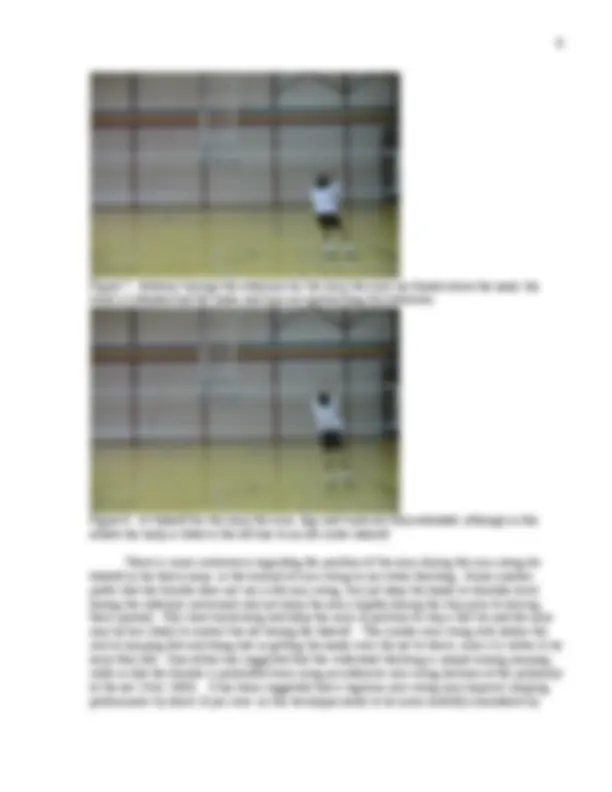
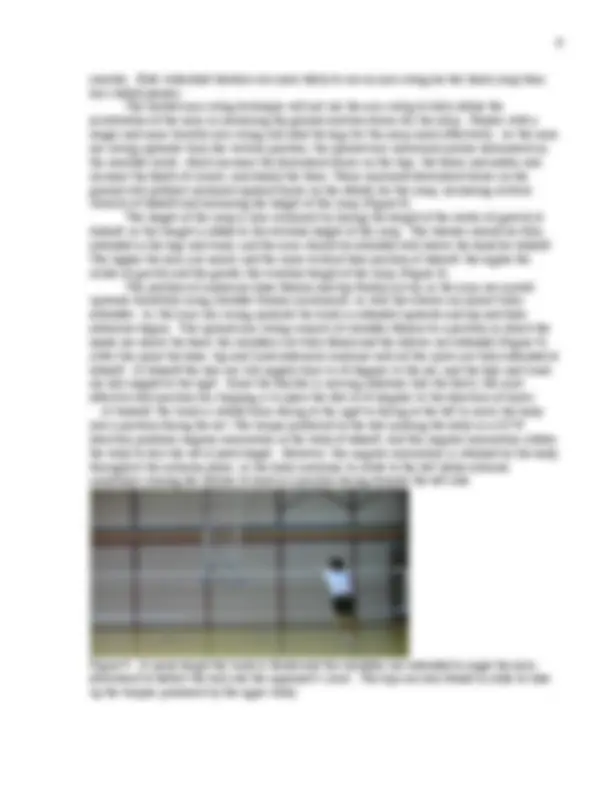
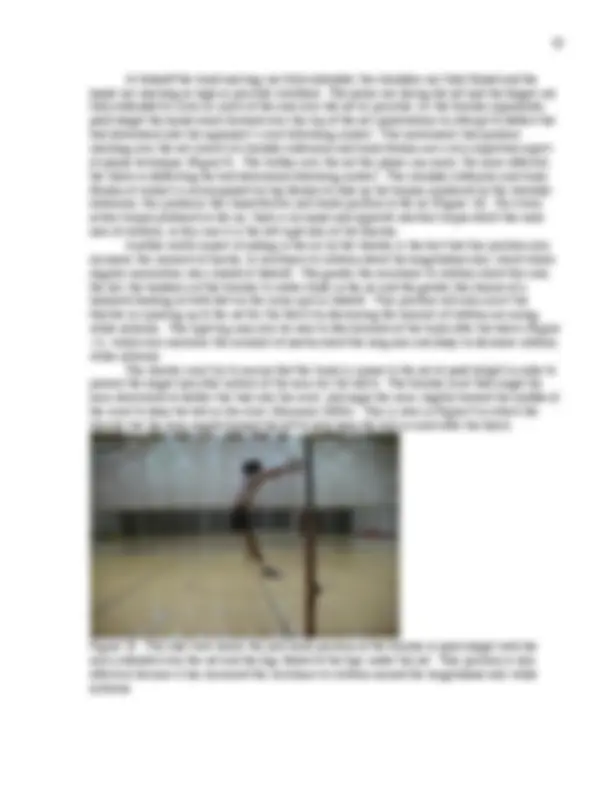
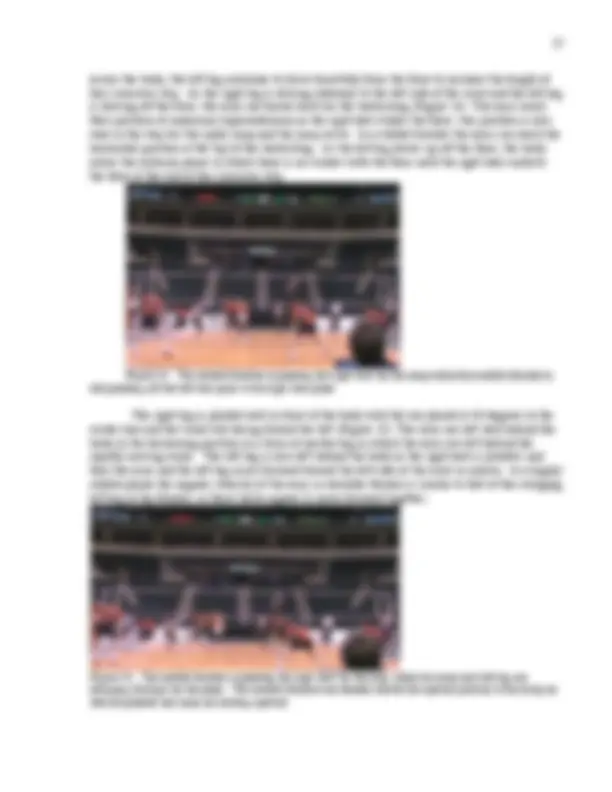
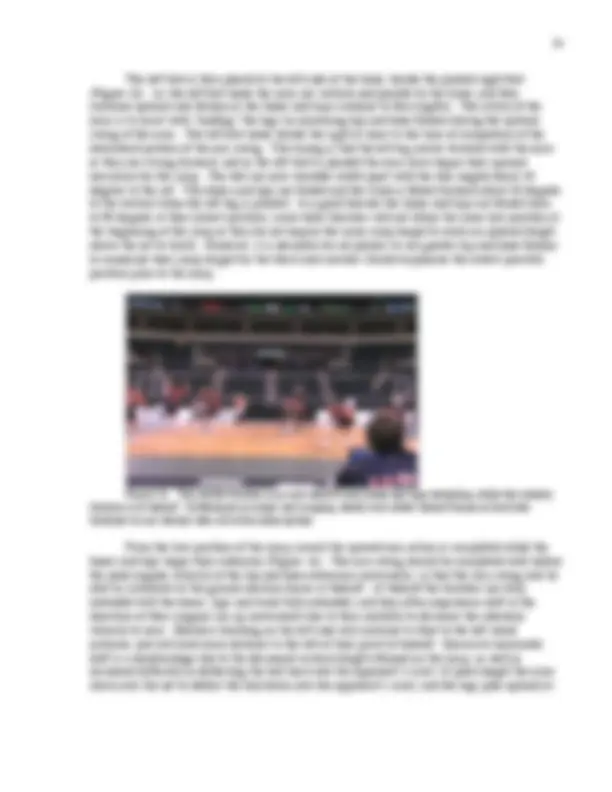
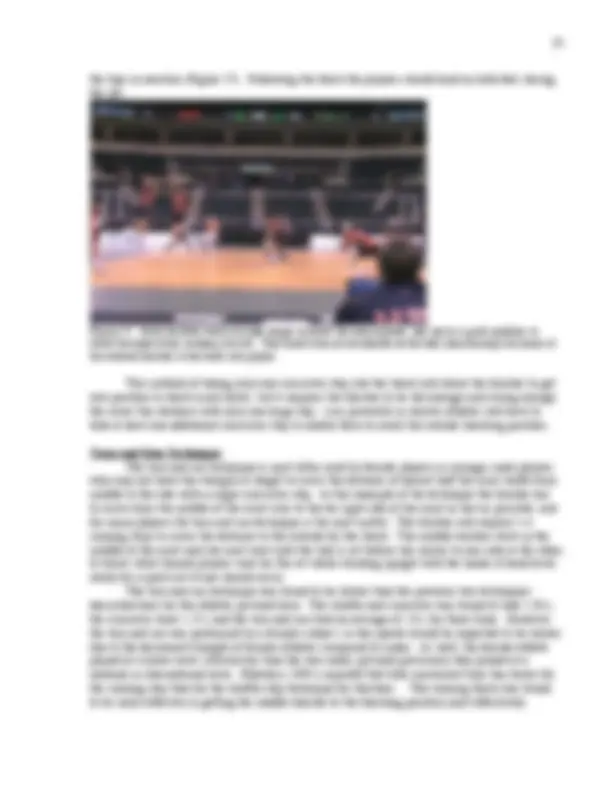
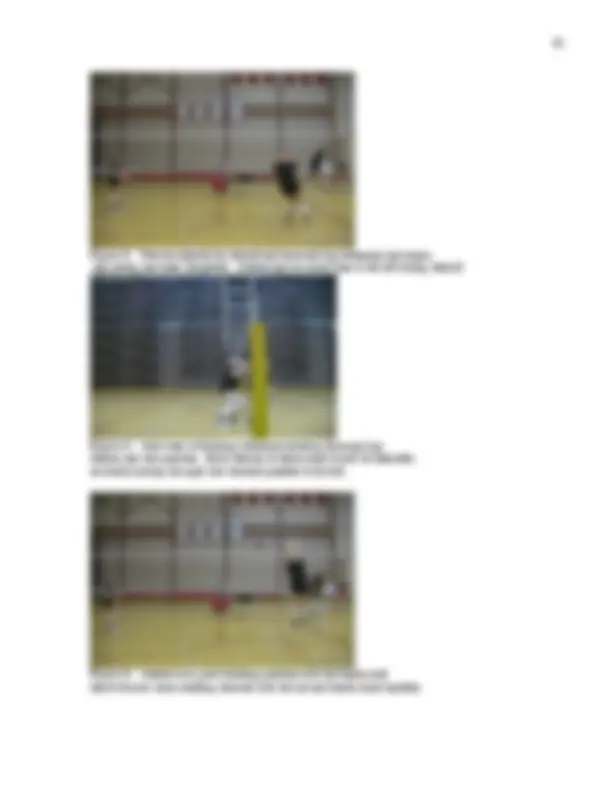





Study with the several resources on Docsity

Earn points by helping other students or get them with a premium plan


Prepare for your exams
Study with the several resources on Docsity

Earn points to download
Earn points by helping other students or get them with a premium plan
Community
Ask the community for help and clear up your study doubts
Discover the best universities in your country according to Docsity users
Free resources
Download our free guides on studying techniques, anxiety management strategies, and thesis advice from Docsity tutors
Blocking in volleyball is a method of defending a spike attack in which the defensive team jumps up at the net and stops the spike from crossing the net by ...
Typology: Lecture notes
1 / 21

This page cannot be seen from the preview
Don't miss anything!














Footwork for the Volleyball Block Introduction Blocking in volleyball is a method of defending a spike attack in which the defensive team jumps up at the net and stops the spike from crossing the net by contacting it with the hands and arms. Blocking is the first line of defense against an attacking opponent. A successful block is accomplished when either the ball rebounds off the hands of the blocker and directly back in to the opponent’s court or deflects off the hands in such a way that the blocker’s team may play the ball (Hammon 2005b). A block has the further advantage for the defensive team that by placing the ball immediately back to the opponent’s court it forces them to put up another attack. Timing is the key to an effective block and the jump must be timed so that the blocker jumps immediately after the attacker jumps, depending on how far the hitter is from the net. The further off the net the hitter is hitting the ball, the later the jump. The blocker should attempt to reach over the top of the net to penetrate over to the opponent’s side of the net. The blocker should be positioned opposite the attacker’s hitting arm (Hammon 2005b). Research has shown that during the spike attack, approximately .34 seconds elapse from the instant of takeoff until the instant of ball contact. Since the preparatory phase (rising into the air and cocking the arm) lasts about .29 sec, only .05 sec are needed to initiate the forward movement of the arm in the attack and strike the ball (Chung, 1988). When applied to the case of the blocker, it is clear that if the blocker has not sealed the net by the time the attacker has begun to accelerate their arm in the forward direction they will not have the time to penetrate the net before the ball has passed them. The only way to make sure the spike is stopped is to penetrate the net early- well before the attacker begins the forward arm swing (Vint, 2005). There are some questions regarding which is the most effective footwork for the block in volleyball, especially the movement to the sides of the court by the middle blocker. Coaches want to know the fastest method to move to the outside position for the block for each type of player, depending on their strength, sex, and speed of movement. The coach wants to know the fastest footwork to get to the outside blocker position, as well the most effective way of stopping and performing the block jump. The effectiveness of a block is measured by the speed of the blocker reaching the outside, the effectiveness of the jumping position, and the position of the player during the block. Many jumping studies (Dapena, 1988) have reported that a more effective run up is one in which the athlete moves faster into the jump, and this horizontal velocity is then used to load the legs for the jump by increasing the depth of crouch. A faster run up requires greater strength from the blocker to reduce the horizontal velocity to close to zero and generate very high vertical velocities for the jump. The blocker should attempt to plant so that they jump straight up and down, so that they land in the same spot from which they jumped (Volleyball 2005). There are three possible ways of moving the feet to get into position to block the hitter on the outside of the court (Bueckers, 1991). The first method is to use the shuffle (slide) step in which the blocker uses 1- 2 shuffle steps prior to the stop to cover the distance to the side for the block. A second technique of footwork for blocking is to use a long crossover step to the right by crossing the left foot over the right, followed by the stop for the block jump. A third technique is to use a series of fast running steps prior to the stop for the jump. This technique is not commonly used by highly skilled players today, however some coaches are experimenting with it’s effectiveness as an alternate technique especially with female players. A shuffle step is a step in which the outside (eg. Right) foot leads with a step in the direction of travel toward the sideline, while the body is being forcefully driven sideways by the leg on the side away from the direction of travel. The stop used in the volleyball block, spike and
In 1991, Bueckers examined the footwork technique which resulted in the fastest lateral movement and jumping times among 10 national caliber female volleyball players. The three footwork techniques that were tested included the slide step, the crossover step and the running step. He reported that total movement time for the running step technique was significantly shorter than for the slide step technique, even though the 90 degree turn required for the lateral movement was time consuming. In spite of the longer movement time for the turn and run phase, the running block was the most effective in getting the middle blocker to the outside takeoff position. It has been suggested that the running step technique should be used for a lateral movement of more than 1.8 m because the travel time and jump and reach time are less (Beal et al., 1987). However, since volleyball coaches generally agree that the slide (shuffle) step technique favors the blocker’s body and hand position in the air, the slide step should be used when no time constraints are present (Bueckers, 1991). Shuffle Step to Stop and Jump This blocking data and photos were part of an analysis of the 2005 NORSECA Championships held in Winnipeg in September 2005. A number of the games were filmed, and the film was used to assist with the description of the blocking footwork. As well, some film was taken of athletes from the University of Manitoba volleyball teams performing blocking skills and drills. Informed consent was requested from all athletes prior to filming their blocking skills. The first type of footwork used by the blocker is the shuffle step into the front stop and block jump. This type of footwork was found to be intermediate in time taken compared to the cross over step, which appears reasonable since the athlete must take one additional step when compared to the straight crossover. The time taken by the athlete in these photos was 1.55 s from start to takeoff, which is reasonable in terms of the movements involved in the skill. This description will refer to a middle blocker moving to the right side to block a spike from the power position on the opponent’s court. The player assumes the ready position for blocking with the feet wider than shoulder width apart and the arms extended above the head (Figure 1). The player places all their weight on the left foot and loads the left leg by flexing the knee and hip (Figure 2). The right foot is raised from the ground and the right hip is laterally rotated to point the toe in the direction of the step. A very long step in the direction of the block is required, which is produced by a forceful extension of the left leg and a long step onto the right leg. This step should be at least 1.5 metres in length in order to position the blocker for the jump and block. The body is rotated to the right as a step is taken onto the right foot (Figure 3). The right foot is planted parallel to the net and is followed by a long crossover step onto the left foot. As the right foot is planted the body is rotated from facing the net to sideways to the net (Figure 4).
Figure 1. Ready position in blocking; player squarely facing the net, feet shoulder width apart, with the hands held at net height, palms forward. Figure 2. The shuffle step consists of a forceful push off from the left leg and a long step to the right with the right toe pointing in the direction of travel. Figure 3. As the right leg is planted the body is turned to face the right and the left leg is swung through in a flexed position.
is swung forward with the knee flexed to ninety degrees and planted beside the left, the arms swing forward and upward to assist the jump (Figure 6). Vertical jump performance may be enhanced by rapidly squatting down at foot plant prior to the propulsive phase of the jump. This lowering sequence in which the knees and hips are flexed to close to ninety degrees and the trunk is flexed forward is called the counter movement because it occurs in the direction that is counter or opposite to the direction of the desired movement (Vint, 2005). During the descent of the counter movement (squatting movement) the hips, knees and ankles are flexed into positions that stretch the muscles that will soon act to extend those same joints during the upward phase of the jump. This prestretch of the muscles and elastic tissues of the joints will increase the force of the extension movements at takeoff by storing elastic energy from the stretch to be released at recoil of the structures (Figure 6). As well this stretch of the muscles will fire the stretch reflex for muscle contraction in which a forceful stretch will fire the muscle spindles in the stretched muscles to cause the muscle to contract more forcefully. This deep squat will also increase the distance over which force can be exerted by the muscle, thereby prolonging the upward propulsion phase. However, each athlete likely has an optimal depth of crouch that will produce the highest jump, depending on their strength, height, and fast twitch muscle fibre percentage (Vint, 2005). Coaches should observe their blockers to note which ones might employ too little or too much of a crouch based on their strength and jumping characteristics prior to the block jump. Figure 6. At the end of the crossover the right foot is brought forward beside the left, and both feet are angled close to 45 degrees to the center line. The body is moving downward for the counter movement. The arms are being accelerated upward at a very high velocity to load the legs for the jump.
Figure 7. Midway through the extension for the jump the arms are flexed above the head, the trunk is extended and the knees and hips are approaching full extension. Figure 8. At takeoff for the jump the arms, legs and trunk are fully extended, although in this athlete the body is tilted to the left due to an off-center takeoff. There is some controversy regarding the position of the arms during the arm swing for takeoff in the block jump; or the amount of arm swing to use when blocking. Some coaches prefer that the blocker does not use a full arm swing, but just keep the hands at shoulder level during the sideways movement and just drop the arms slightly during the stop prior to driving them upward. This short backswing will keep the arms in position to stop a fast hit and the arms may be less likely to contact the net during the takeoff. The smaller arm swing will reduce the risk of jumping late and being late in getting the hands over the net to block, since it is better to be early than late. One author has suggested that the volleyball blocking is unique among jumping skills in that the blocker is prohibited from using an extensive arm swing because of the proximity to the net (Vint, 2005). It has been suggested that a vigorous arm swing may improve jumping performance by about 10 per cent, so this technique needs to be more carefully considered by
At takeoff the trunk and legs are fully extended, the shoulders are fully flexed and the hands are reaching as high as possible overhead. The palms are facing the net and the fingers are fully extended to cover as much of the area over the net as possible. As the blocker approaches peak height the hands reach forward over the top of the net (penetration) to attempt to deflect the ball downward into the opponent’s court following contact. The movements that produce reaching over the net consist of shoulder extension and trunk flexion are a very important aspect of player technique (Figure 9). The further over the net the player can reach, the more effective the block in deflecting the ball downward following contact. The shoulder extension and trunk flexion at contact is accompanied by hip flexion to take up the torques produced by the shoulder extension- this produces the characteristic jack knife position in the air (Figure 10). For every action torque produced in the air, there is an equal and opposite reaction torque about the same axis of rotation, in this case it is the left right axis of the blocker. Another useful aspect of piking in the air by the blocker is the fact that this position also increases the moment of inertia, or resistance to rotation about the longitudinal axis, about which angular momentum was created at takeoff. The greater the resistance to rotation about this axis, the less the tendency of the blocker to rotate while in the air and the greater the chance of a balanced landing on both feet on the same spot as takeoff. This position will also assist the blocker in squaring up to the net for the block by decreasing the amount of rotation occurring while airborne. The right leg may also be seen to flex forward of the trunk after the block (Figure 11), which also increases the moment of inertia about the long axis and helps to decrease rotation while airborne. The blocker must try to ensure that the trunk is square to the net at peak height in order to present the largest possible surface of the arms for the block. The blocker must then angle the arms downward to deflect the ball into the court, and angle the arms slightly toward the middle of the court to keep the ball in the court (Hammon 2005a). This is seen in Figure 9 in which the blocker has the arms angled toward the left to help keep the ball in court after the block. Figure 10. The side view shows the jack knife position of the blocker at peak height with the arms extended over the net and the legs flexed at the hips under the net. This position is also effective because it has increased the resistance to rotation around the longitudinal axis while airborne.
Figure 11. On the left side of the court the two blockers land from a block. The blocker on the right is incorrectly landing on one foot, producing high stresses on that leg. Both blockers experienced significant drift to the left during the block jump. After peak height is reached, the blocker must move the arms back upwards (shoulder flexion) to the vertical, to ensure that no net contact is made on the way down. As the arms and trunk move backwards in a counterclockwise direction, the legs move backwards in a clockwise direction around the left right axis to keep the sum of the torques in the airborne body constant. The player should try to land on both feet at the same time, close to the spot from which takeoff occurred (Figure 11). Landing on close to the same spot will help ensure that there is no forward drift associated with the jump that would tend to move the blocker into the net. However, most skilled blockers are seen to move toward the sideline in the direction of the original motion while airborne, due to the horizontal velocity toward the sideline they had at takeoff. After landing, the player resumes their ready position facing the net with the hands held at shoulder height in preparation for the next block. Long Crossover Step to Block Jump Another technique often used by highly skilled volleyball middle blockers is to take just one long crossover step to the side, followed by the trail leg moving forward to be placed beside the crossover foot in preparation for the jump. This technique differs from the previous technique in that the player does not take the initial long shuffle step onto the leg on the side closest to the sideline. The blocker simply pivots on this foot, and takes the first long step onto the foot closest to the middle, making this a crossover step. Since the middle blocker and the outside blocker take only one step from the middle to the side of the court for the block, this must be a very long step and requires a powerful push off by the middle blocker. Shorter or less powerful players may not be able to make this one long step into position to block. This technique was found to have the fastest time from start to leaving the ground on the spike jump, a time of 1.13 s for the middle blocker.
across the body, the left leg continues to drive forcefully from the floor to increase the length of this crossover step. As the right leg is driving sideways to the left side of the court and the left leg is driving off the floor, the arms are drawn back for the backswing (Figure 14). The arms reach their position of maximum hyperextension as the right heel strikes the floor- this position is also seen in the stop for the spike jump and the jump serve. In a skilled blocker the arms can reach the horizontal position at the top of the backswing. As the left leg drives up off the floor, the body enters the airborne phase in which there is no contact with the floor until the right heel contacts the floor at the end of the crossover step. Figure 14. The outside blocker is planting the right foot for the jump while the middle blocker is still pushing off the left foot prior to the right foot plant. The right leg is planted well in front of the body with the toe placed at 45 degrees to the center line and the trunk still facing toward the left (Figure 15). The arms are left well behind the body in the backswing position in a form of inertial lag in which the arms are left behind the rapidly moving trunk. The left leg is also left behind the body as the right heel is planted, and then the arms and the left leg move forward toward the left side of the court in unison. In a highly skilled player the angular velocity of the arms in shoulder flexion is similar to that of the swinging left leg in hip flexion, so these limbs appear to move forward together. Figure 15. The middle blocker is planting his right foot for the stop, while the arms and left leg are swinging through for the plant. The outside blocker has already started the upward portion of the jump as feet are planted and arms are driving upward.
The left foot is then placed to the left side of the body, beside the planted right foot (Figure 16). As the left foot lands the arms are vertical and parallel to the trunk, and they continue upward into flexion as the knees and hips continue to flex slightly. The action of the arms is to assist with “loading” the legs by increasing hip and knee flexion during the upward swing of the arms. The left foot lands beside the right at close to the time of completion of the downward portion of the arm swing. The timing is that the left leg moves forward with the arms as they are swung forward, and as the left foot is planted the arms have begun their upward excursion for the jump. The feet are now shoulder width apart with the toes angled about 45 degrees to the net. The knees and hips are flexed and the trunk is flexed forward about 30 degrees to the vertical when the left leg is planted. In a good blocker the knees and hips are flexed close to 90 degrees at their lowest position; some taller blockers will not attain the same low position at the beginning of the jump as they do not require the same jump height to reach an optimal height above the net to block. However, it is desirable for all players to use greater hip and knee flexion to maximize their jump height for the block and coaches should emphasize the lowest possible position prior to the jump. Figure 16. The middle blocker is in mid takeoff with knees and hips extending while the outside blocker is at takeoff. Differences in height and jumping ability will affect takeoff times so that both blockers do not always take off at the same instant. From the low position of the jump crouch the upward arm action is completed while the knees and hips begin their extension (Figure 16). The arm swing should be completed well before the peak angular velocity of the hip and knee extension movements, so that the arm swing will be able to contribute to the ground reaction forces at takeoff. At takeoff the blockers are fully extended with the knees, hips and trunk fully extended, and they often experience drift in the direction of their original run up movements due to their inability to decrease the sideways velocity to zero. Blockers blocking on the left side will continue to float to the left while airborne, and will land some distance to the left of their point of takeoff. Excessive horizontal drift is a disadvantage due to the decreased vertical height attained on the jump, as well as increased difficulty in deflecting the ball back into the opponent’s court. At peak height the arms reach over the net to deflect the ball down into the opponent’s court, and the legs pike upward at
Figure 18. Blocker in good ready position with hands up waiting for the set to determine her direction of motion. In this case the blocker is moving to the right side of the court to block a ball that has been set to the power side of the opponent’s court. After the ball is set, the blocker takes the first step onto the right foot (Figure 19). This is not an actual step but it is the weighting of the right foot while laterally rotating the right leg to face the direction of travel. The blocker pivots on this outside right foot and turns to face the direction of travel by pivoting on the right foot. As the right leg is rotated and weighted, the left leg is lifted and a step is taken to the right. This step with the left foot is followed by a step onto the right foot. These steps should be as long and powerful as possible in order for the player to cover the distance to the outside block as quickly as possible. The arms may use running type movements, in which the arms pump forward and back in rhythm with the legs (Figure 19); or the arms may remain in the blocking position with the hand held at about shoulder level. Figure 19. Blocker turns and runs in the direction of the block, by pivoting on her right foot, turning to face the direction of the block, and taking the first running step onto the left foot.
Figure 20. Blocker continues her running motion by pushing off the left foot and landing on the right foot for the 2nd^ step. Figure 21. Blocker takes the 3rd^ step onto the left foot, which is also the plant step for the block jump. The foot is placed at a 45 degree angle to the center line and lands heel first. The final step is a step onto the left foot following a forceful push off from the right foot. This last step onto the left foot is the longest step of the sequence and serves and the plant step for the front stop. The body remains airborne as the weight is driven from the right foot onto the plant leg (Figure 21). The left leg crosses over in front of the right and the foot is planted at an angle of 45 degrees to the center line. Following the left foot plant the right foot is brought forward beside the left and planted at a slightly greater angle to the center line. When the feet are planted at the beginning of the jump, the movements for the jump will begin (Figure 22).
Figure 25. Athlete is in good blocking position close to the net with hands well above the net. Arms could be extended further over the net to ensure the ball is deflected downward by the block. Many female players and younger, less skilled players do not use an extensive arm swing during the block jump, as coaches often suggest that it moves the hands too far from the ready position for the block. Many female players keep the hands at head level during the run up and the block jump, so the arm swing has a limited role in loading the legs for the jump (Figure 21). If female players used a longer and more forceful arm swing, they would likely be able to deepen their crouch for the jump and therefore increase the height of the jump. However, it may also be true that a higher jump is less important than a jump with correct timing so that the blocker reaches her peak height at the time the ball is crossing the net. A longer arm swing may make this timing of the block jump more difficult and lead to more errors in the block. As the player deepens the crouch prior to the jump, many players are seen to experience medial rotation of the hip joints during knee flexion that produces a knock kneed (knees in valgus) position. This valgus knee position is seen in both male and female highly skilled jumpers (Figure 22). This position may increase the effectiveness of the quadriceps contraction by stretching the vastus medialis muscle and producing a stronger contraction of this head of the quadriceps muscle in knee extension. From the crouch position the player extends the knees, hips and trunk and drives the arms to a position above the head. As the player approaches peak height the arms are moved downwards over the top of the net into a position of shoulder extension and the body assumes a slight pike position (Figure 24). From peak height the player should attempt to land on both feet equally and close to the same spot as takeoff occurred. However, most players are still drifting from the run up during the jump and will tend to land closer to the sidelines than the point where takeoff occurred. Training for the Block The type of blocking footwork used by a volleyball player is dependent on their strength and jumping ability. A very tall and strong player can move from the middle blocking position to the outside by use of a single long crossover step onto the middle foot, followed by a step in with the outside foot. An elite national or international player might be expected to be able to perform this footwork into the block. Many collegiate players require a long shuffle step from the outside foot prior to the crossover step onto the middle foot. This extra step will enable the player to reach the outside with only one extra step; and will provide additional linear momentum toward the sidelines that may be used for
the loading of the legs for the jump. Other players prefer the turn and run technique that provides a fast approach to the block as well as enabling the player to cover the distance quickly. One drawback of the turn and run technique is that it causes the blocker to turn sideways to the net as they run to the sideline. This increases the difficulty of returning to the blocking position in which the body is squarely facing the net. This sideways facing position may force the blocker to acquire angular momentum toward the net at takeoff and this momentum may force the blocker to continue to rotate through the block.